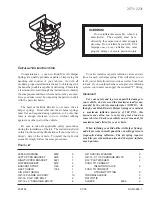
the wheel balancer.
REMAINING AMOUNT OF UNBALANCE CONFIRMATION
1. After installing the outer and inner balance weights, operate the wheel balancer again.
2. Confirm that the remaining unbalance does not exceed following on either side.
Standard
WHEEL SPECIFICATIONS
TIRE PRESSURE ADJUSTMENT (WITH TPMS)
1. Use of a digital gauge is recommended for accurate measurement of the air pressure.
2. Tire pressure lowers gradually as time passes. Due to this, monthly air pressure inspection is
recommended.
3. Perform tire pressure adjustment before driving. (When tires are cold.)
z
Tire pressure will increase after driving because the internal temperature of the tire is high. If tire
pressure is adjusted to specifications when the internal temperature of the tire is high, tire pressure
will decrease when the internal temperature of the tire decreases to the same level as ambient
temperature. If the tire pressure is lower than the lower-limit pressure, the TPMS warning light may
illuminate.
z
Even though the air pressure is adjusted to specifications, the indicated air pressure may be higher
than the specified value when the internal temperature of the tire is higher than ambient
CAUTION:
z
Do not attach 3 or more balance weights.
z
One balance weight must not exceed 60g {2.12 oz}, and a total
of 2 balance weights must not exceed 100g {3.53 oz}.
Fig. 3: Locating Wheel Balance Position
Courtesy of MAZDA MOTORS CORP.
Outer
Inner
18 inch wheel 10 g {0.35 oz} 6 g {0.21 oz}
20 inch wheel 6 g {0.21 oz} 4g {0.14 oz}
2008 Mazda CX-9 Grand Touring
2008 SUSPENSION Wheels and Tires - Mazda CX-9
Microsoft
Sunday, November 15, 2009 10:26:54 AM
Page 4
© 2005 Mitchell Repair Information Company, LLC.
















































